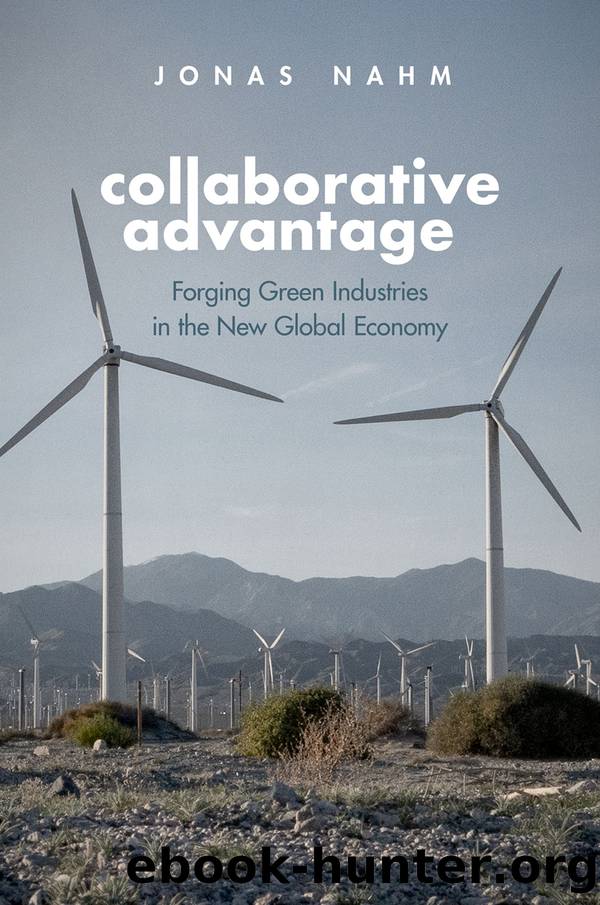Collaborative Advantage by Jonas Nahm

Author:Jonas Nahm
Language: eng
Format: epub, pdf
Publisher: Oxford University Press
Published: 2021-06-15T00:00:00+00:00
Table 5.3 Goldwind Wind Turbine Collaboration
Year Program Goal Technology Source
1998 600 KW turbine Jacobs Energie, Germany (license)
2001 1.2 MW turbine (direct drive) Vensys, Germany (license)
2005 1.5 MW turbine (direct drive) Vensys Germany (license)
2010 2.5/5 MW turbine (direct drive) Vensys Germany (joint development)
2012 10 MW offshore Vensys Germany (joint development)
Source: CRESP 2005; Ministry of Science and Technology 2007; Author Interview, Beijing, March 23, 2015.
The second source of technology for Chinaâs domestic turbine manufacturers involved global suppliers, many of which eventually established local production facilities in response to local content requirements.58 Foreign firms also began sourcing from Chinese suppliers and, in turn, helped these suppliers meet global technical standards.59
In the solar sector, Chinese scientists educated at the worldâs top solar laboratories founded the majority of firms. Research funding dispensed through the 863 and Torch Programs, together with support for high-technology firms in HTZs, attracted these scientists back to China. The technological skills of foreign-trained returnees obviated the need for licenses and joint development agreements common in the wind industry, but solar firms still tapped into global technology networks, in particular for production equipment. Foreign equipment manufacturers quickly established Chinese sales networks.60 Foreign partners provided access to key technologies, capabilities, and components that Chinese wind and solar manufacturers could not establish in-house. But they had less ability to help Chinese producers scale new technologies to mass production.
In such collaborations, Chinaâs wind and solar firms focused their R&D efforts on building skills that could not be accessed in global supply chains: knowledge-intensive capabilities in scale-up and mass manufacturing that I refer to as innovative manufacturing.61 These proficiencies built on existing manufacturing capabilities in Chinaâs economic development zones, yet they traveled far beyond mere fabrication and assembly, utilizing engineering and design knowledge to translate complex technologies into mass-manufacturable products. Innovative manufacturing included improvements to process designs long associated with manufacturing innovation, but also entailed far-reaching changes to product designs to accommodate manufacturing requirements and meet cost targets for final products. Engineering teams in Chinaâs wind and solar firms met their production and cost targets through the substitution of materials, the redesign of particular components, and the reorganization of internal product architectures to allow for better and faster manufacturability at scale.62
As executives repeatedly highlighted in interviews, most firms relied on global partners to access new technologies, so what set them apart from one another in the highly competitive wind and solar market was their ability to achieve higher speeds and lower costs in manufacturing.63 Heads of technical departments in wind turbine and solar PV manufacturing firms frequently discussed the importance of design capabilities for achieving cost and speed targets in the commercialization of renewable energy technologies, even when an external firm had originally developed those technologies. Many reported either significantly redesigning licensed turbine technologies or observing similar improvements in technologies licensed by local partners and competitors.
To specialize in innovative manufacturing was not a monolithic enterprise. Yes, these firms all needed advanced capabilities in product design; yet their work differed from the ideal of autonomous technology development that resided at the heart of Beijingâs indigenous innovation strategy.
Download
This site does not store any files on its server. We only index and link to content provided by other sites. Please contact the content providers to delete copyright contents if any and email us, we'll remove relevant links or contents immediately.
Chaco's Northern Prodigies : Salmon, Aztec, and the Ascendancy of the Middle San Juan Region after AD 1100 by Paul F. Reed(355)
Law Enforcement Interpersonal Communication and Conflict Management by Brian Douglas Fitch(347)
Digital International Relations by Unknown(344)
Critical Perspectives on Human Security : Rethinking Emancipation and Power in International Relations by David Chandler; Nik Hynek(328)
Skilled interpersonal communication: Research, theory and practice, Fifth edition by Owen Hargie(326)
The Enduring Color Line in U.S. Athletics by Krystal Beamon Chris M. Messer(323)
Evidence-Based Policy Making in Labor Economics by Hamermesh Daniel S.;Nottmeyer Olga K.;Nottmeyer Olga;King Sarah;King Sarah;King Sarah;(297)
EPSO CAST Political affairs EU policies: How to succeed in the selection procedure by Franco Reverte José María(290)
Writing Public Policy - A Practical Guide to Communicating in the Policy Making Process by Catherine F. Smith(272)
Criminological Theory in Context by John Martyn Chamberlain(269)
Tibeton Yoga Its Secret Doc by Evans-Wentz(265)
Threshold Concepts in Women's and Gender Studies by Christie Launius Holly Hassel(262)
Rothschild and Early Jewish Colonization in Palestine (Geographical Perspectives on the Human Past) by Ran Aaronsohn(262)
Positive Psychology and Spirituality in Counselling and Psychotherapy (Conflict, Ethics, and Spirituality, 12) by unknow(261)
Social Problems, Social Issues, Social Science by James Wright(259)
Play in child development and psychotherapy: toward empirically supported practice by Sandra W. Russ(252)
Cognitive Development in Infancy and Childhood (Elements in Child Development) by Mary Gauvain(251)
Latin American Politics and Society by Gerardo L. Munck & Juan Pablo Luna(221)
What Makes a Social Crisis?: The Societalization of Social Problems by Jeffrey C. Alexander(220)
